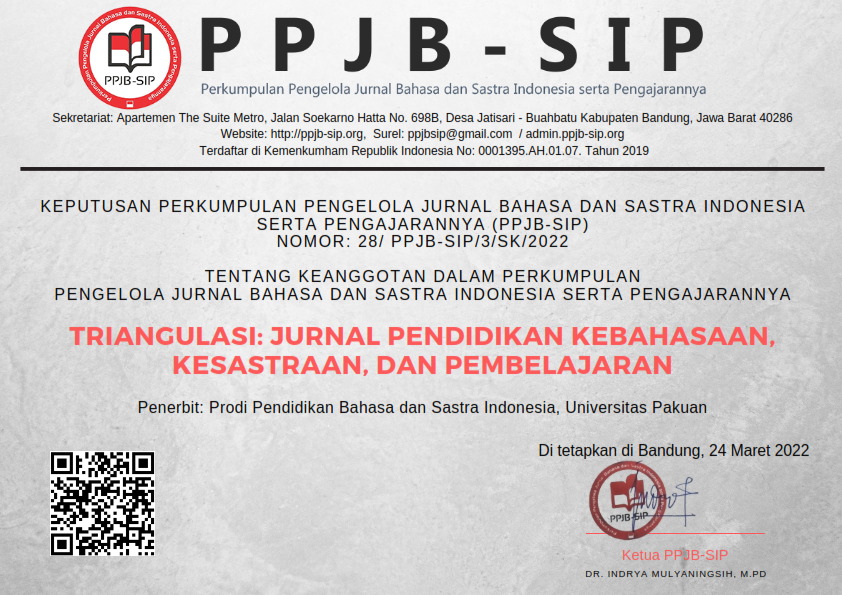Analisis Penggunaan Kohesi Leksikal pada Teks Cerita Pendek Siswa Kelas XI SMA Negeri 4 Bogor
Abstract
Keywords
References
Ahmadi, Muhsin. 1990. Dasar-dasar komposisi. Malang: YA3.
Amertawengrum, Indiyah Prana. 2010. â€Teks dan Intertekstualitasâ€. Jurnal Magistra No. 73 Th. XXII September 2010.
Aminudin. 2010. Kreatif Menulis Puisi dan Cerita Pendek. Tanggerang: Citralab.
Arifin, E. Zaenal, dkk. 2014. Morfologi Bahasa Indonesia untuk Program Studi Pendidikan Bahasa dan Sastra. Tangerang: Pustaka Mandiri.
Arifin, E. Zaenal, dkk. 2015. Wacana Transaksional dan Interaksional dalam Bahasa Indonesia. Tangerang: Pustaka Mandiri.
Badan Pengembangan dan Pembinaan Bahasa Kementrian
Pendidikan dan Kebudayaan. 2016. Pedoman Umum Ejaan Bahasa Indonesia. Jakarta.
Indiyastini, T. 2009. Kohesi dan Koherensi Paragraf dalam Bahasa Jawa. Yogyakarta: Balai Bahasa Yogyakarta.
Kosasih, E. 2014. Jenis-jenis Teks. Bandung: YramaWidya.
Kurhartanti, Yuwono, dkk. 2005. Pesona Bahasa Langkah Awal Memahami Linguistik. Jakarta: PT Gramedia.
Mulyana. 2005. Kajian Wacana: Teori, Metode dan Aplikasi Prinsip-Prinsip Analisis Wacana. Yogyakarta: Tiara Wacana.
M.S. Mahsum. 2014. Teks dalam Pembelajaran Bahasa Indonesia. Jakarta: PT Raja Grafindo Persada.
Parera, JD. 1993. Leksikon Istilah Pembelajaran Bahasa. Jakarta: Gramedia.
Priyatni, Endahtri. 2015. Desain Pembelajaran Bahasa Indonesia dalam Kurikulum 2013. Jakarta: Bumi Aksara.
Rokhmansyah, Alfian. 2014. Studi dan Pengkajian Sastra: Perkenalan Awal Terhadap Ilmu Sastra. Yogyakarta: Graha Ilmu.
Suryadi Adi. 2016. Analisis Kohesi Paragraf Pada Cerita Pendek Pak Molla Karya James Danandjaja†dalam Lingua: Jurnal Cerita Pendek. Jamuari 2017.
Supardo, Susilo. 1998. Bahasa Indonesia dalam Konteks. Jakarta: Depdikbud, Dirjen Dikti, L2LPTK. Suwarna, Dadan. 2016. Kreatif dan Cerdas Berbahasa Indonesia. Depok: Khalifah Mediatama.
Suladi. 2000. Kohesi dalam Media Massa Cetak Bahasa Indonesia. Jakarta: Pusat Bahasa Departemen Pendidikan Nasional.
Sumarlam. 2003. Teori dan Praktik Analisis Wacana. Surakarta: Pustaka Cakra.
Tarigan, H Guntur. 2013. Pengajaran Gaya Bahasa. Bandung: Angkasa.
Tarigan, H Guntur. 1988. Pengajaran Pemerolehan Bahasa. Jakarta: Departemen Pendidikan dan Kebudayaan.
Tarigan, H Guntur. 2009. Pengajaran Wacana. Bandung: Angkasa.
Zaimar, O.K.S dan Ayu Basoeki Harahap. 2015. Teori Wacana. Jakarta: Penaku.
DOI: 10.55215/triangulasi.v1i1.3217
 Abstract views : 1170
Abstract views : 1170
Refbacks
- There are currently no refbacks.
Copyright (c) 2021 Triangulasi: Jurnal Pendidikan Kebahasaan, Kesastraan, dan Pembelajaran

This work is licensed under a Creative Commons Attribution-NonCommercial-ShareAlike 4.0 International License.




